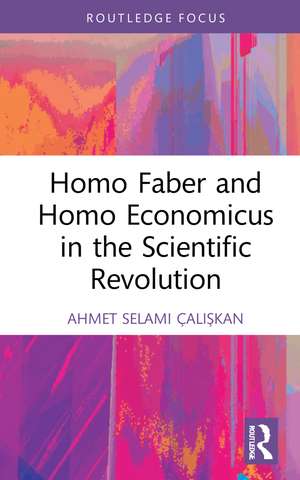Homo Faber and Homo Economicus in the Scientific Revolution
Autor Ahmet Selami Çalışkanen Limba Engleză Hardback – 25 apr 2022
Why did the scientific revolution take place in the West and not in China or the Islamic world? How did humanity’s progress in science and technology, which had been moving along at a relatively steady pace for tens of thousands of years, end up taking such an unprecedented leap? Subjecting the history of thought and technology to a novel interpretation based on the relationship between theory and practice, Ahmet Selami Çalışkan argues that the industrial revolution and modern science—and the scientific revolution that preceded both—did not alone suffice to sort out the philosophical problems of their day or to produce the institutions of the modern age. Both required a new sort of human: Homo economicus faber.
Tracing the historical emergence of this figure and its persistence in our own age, this book offers an innovative and holistic assessment of the economic, cultural and political effects of centuries of interaction between East and West and their repercussions in our world today.
| Toate formatele și edițiile | Preț | Express |
|---|---|---|
| Paperback (1) | 170.51 lei 6-8 săpt. | |
| Taylor & Francis – 27 mai 2024 | 170.51 lei 6-8 săpt. | |
| Hardback (1) | 469.34 lei 6-8 săpt. | |
| Taylor & Francis – 25 apr 2022 | 469.34 lei 6-8 săpt. |
Preț: 469.34 lei
Nou
Puncte Express: 704
Preț estimativ în valută:
89.82€ • 93.43$ • 74.15£
89.82€ • 93.43$ • 74.15£
Carte tipărită la comandă
Livrare economică 14-28 aprilie
Preluare comenzi: 021 569.72.76
Specificații
ISBN-13: 9781032231075
ISBN-10: 1032231076
Pagini: 136
Ilustrații: 20 Halftones, black and white; 20 Illustrations, black and white
Dimensiuni: 138 x 216 x 10 mm
Greutate: 0.45 kg
Ediția:1
Editura: Taylor & Francis
Colecția Routledge
Locul publicării:Oxford, United Kingdom
ISBN-10: 1032231076
Pagini: 136
Ilustrații: 20 Halftones, black and white; 20 Illustrations, black and white
Dimensiuni: 138 x 216 x 10 mm
Greutate: 0.45 kg
Ediția:1
Editura: Taylor & Francis
Colecția Routledge
Locul publicării:Oxford, United Kingdom
Cuprins
Preface
Introduction
Chapter 1: Imitation
1.1 Ancient Relations
1.2 Tekhne as Imitation of Nature
Chapter 2: The Epistemological Transformation of Secret Knowledge
2.1 Magia Naturalis
2.2 "Privileged Knowledge" as a Question of Property
Chapter 3: Quantification
3.1 New Environment, New Awareness, and Space-Time Concentration
3.2 Quantitative Quality and Anthropocentric Knowledge
3.3 Quantification and Functional Art
3.4 Epistemological Effects of the Quantification
3.5 Galileo and Re-Building of Scientific Demonstration
3.6 Scientia Experimentalis as the Origins of New-Experiment
Chapter 4: The Space of the New Knowledge
4.1 The Possibility of Storable and Publishable Knoweldge: Kunstkammer
4.2 Laboratory as Knowledge Workshop
4.3 The New Knowledge’s Artificial Nature: Mechanical Arts
Chapter 5: Mechanization
5.1 Scientific Tools as means of Applied Philosophy
5.2 Continuity and Transmission of Knowledge: Official Curriculum
Chapter 6: Transformation of Tekhne
6.1 The Solidarity between Homo economicus and Homo faber
6.2 From Tekhne to Phronetic Tekhne
Conclusion
Introduction
Chapter 1: Imitation
1.1 Ancient Relations
1.2 Tekhne as Imitation of Nature
Chapter 2: The Epistemological Transformation of Secret Knowledge
2.1 Magia Naturalis
2.2 "Privileged Knowledge" as a Question of Property
Chapter 3: Quantification
3.1 New Environment, New Awareness, and Space-Time Concentration
3.2 Quantitative Quality and Anthropocentric Knowledge
3.3 Quantification and Functional Art
3.4 Epistemological Effects of the Quantification
3.5 Galileo and Re-Building of Scientific Demonstration
3.6 Scientia Experimentalis as the Origins of New-Experiment
Chapter 4: The Space of the New Knowledge
4.1 The Possibility of Storable and Publishable Knoweldge: Kunstkammer
4.2 Laboratory as Knowledge Workshop
4.3 The New Knowledge’s Artificial Nature: Mechanical Arts
Chapter 5: Mechanization
5.1 Scientific Tools as means of Applied Philosophy
5.2 Continuity and Transmission of Knowledge: Official Curriculum
Chapter 6: Transformation of Tekhne
6.1 The Solidarity between Homo economicus and Homo faber
6.2 From Tekhne to Phronetic Tekhne
Conclusion
Notă biografică
Ahmet Selami Çalışkan holds a master’s degree in political history and international relations from Marmara University, where he also earned a PhD with his dissertation "The Paradigm and Founder Effect of Practice in Modern Science." He is the CEO of Tekhnelogos Software, an R&D center that conducts artificial intelligence-based projects. He is also the chairman of the board of directors of Istanbul Jazari Museum.
Descriere
This book tells the story of how the "servile arts" turned into the "mechanical arts," which in turn developed into a kind of philosophical apparatus that made modern science possible.
